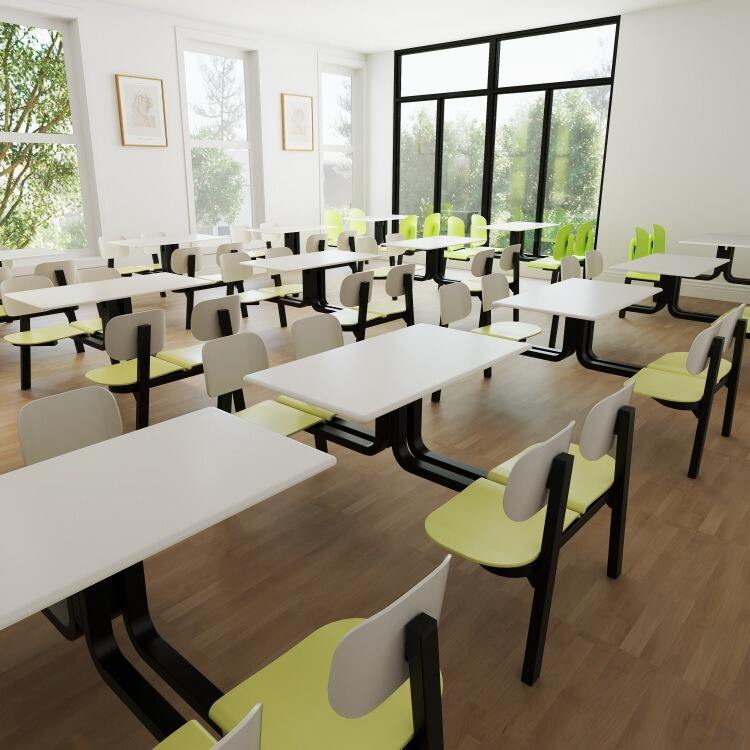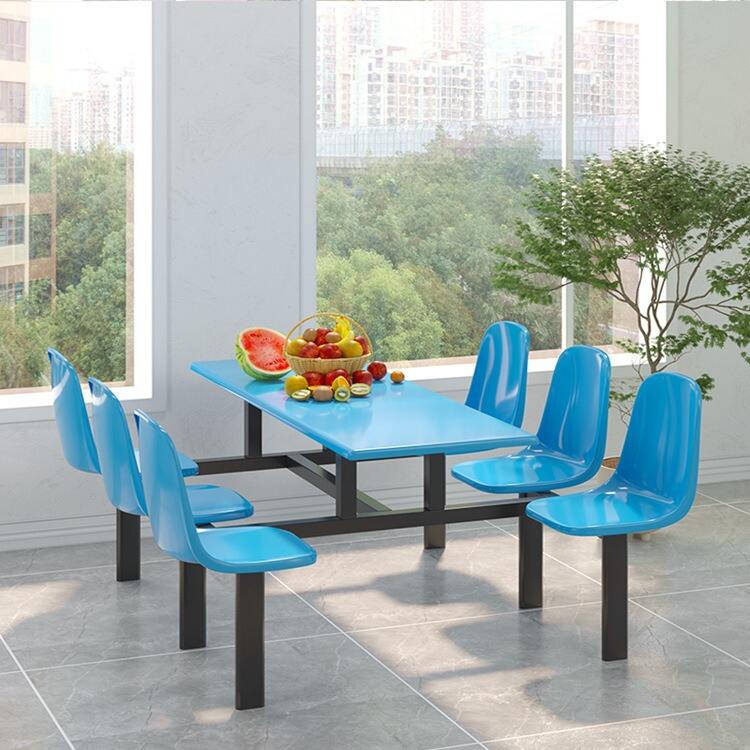စားသောက်ဆိုင်များတွင် စားပွဲနှင့်ခုံများရွေးချယ်စဉ် သက်မှတ်ခြင်းနှင့် အလှအပကို မည်သို့မျှတစွာရွေးချယ်ရမလဲ
စားသောက်ဆိုင်များတွင် စားပွဲခုံများ၏ သက်တောင့်သက်သာဖြစ်မှုနှင့် အလှအပကို မိတ်ဆက်ခြင်း
ယနေ့ခေတ်တွင် စားသောက်ဆိုင်များသည် လူများသည် အစာစားသည့်နေရာများအဖြစ်သာမက စားသောက်ခြင်းသည် အများအာရုံကို ပူးပေါင်းဆောင်ရွက်သည့် အတွေ့အကြုံတစ်ခုဖြစ်သည့် ပတ်ဝန်းကျင်များဖြစ်ပါသည်။ အမ်ဘီယန့်၊ ဒီဇိုင်းနှင့် သက်တောင့်သက်သာဖြစ်မှုတို့သည် စားသောက်ဆိုင်၏ ဝန်ဆောင်မှုနှင့် အစားအစာများကဲ့သို့ပဲ ဖောက်သည်များ၏ ကျေနပ်မှုတွင် အခန်းကဏ္ဍများကို ပါဝင်ပါသည်။ ဤအတွေ့အကြုံကိုဖန်တီးရာတွင် အဓိကအခန်းကဏ္ဍမှာ စားပွဲခုံများဖြစ်ပါသည်။ စားပွဲများနှင့် ကုလားထိုင်များ သည် စားသောက်ဆိုင်တိုင်း၏ စားသောက်နေရာများ၏ အခြေခံဖြစ်ပါသည်။ ဖောက်သည်များသည် ဘယ်နှစ်ကြိမ်နေထိုင်မည်ကို၊ သူတို့ခံစားရသည့် သက်တောင့်သက်သာရှိမှုနှင့် စားသောက်ဆိုင်၏ မိန့်ခွန်းကို မည်သို့မြင်သည်ကို သိမ်းဆည်းပေးပါသည်။ စားပွဲခုံများရွေးချယ်စဉ် သက်တောင့်သက်သာဖြစ်မှုနှင့် အလှအပကို မည်သို့မျှတစွာရွေးချယ်ရမလဲ စားပွဲများနှင့် ကုလားထိုင်များ သည် လုပ်ဆောင်မှုနှင့် ပတ်ဝန်းကျင်ကို တိုက်ရိုက်သက်ရောက်မှုရှိသောကြောင့် အရေးကြီးပါသည်။ အလှတရားကို အလွန်အကျွံအာရုံစိုက်ပါက ဖောက်သည်များ ပြန်လာရန်ဆန္ဒမရှိသော အဆင်မပြေသည့် အပန်းဖြေပေးသည့် အစီအစဉ်များကို ဖြစ်စေနိုင်ပြီး အဆင်ပြေမှုကို အာရုံစိုက်ခြင်းမပြုဘဲ သဘောသဘာဝကို လျစ်လျူရှုပါက စားသောက်ဆိုင်၏ သီချင်းကိုက်ညီမှုမရှိခြင်း သို့မဟုတ် စားသောက်ဆိုင်၏ သီချင်းနှင့် မကိုက်ညီသော စားသောက်ဆိုင်ကို ဖြစ်စေနိုင်ပါသည်။
စားပွဲနှင့် ခုံများတွင် အဆင်ပြေမှု၏ အရေးပါမှု
စားသောက်မှုအတွေ့အကြုံကို တိုးတက်စေခြင်း
အဆင်ပြေသော နားနေခုံများနှင့် ကောင်းစွာဒီဇိုင်းထုတ်ထားသော စားပွဲများသည် ဖောက်သည်များအား စိတ်ကူးများမှ လုံးဝပျော်မွေ့စွာ စားသောက်နိုင်စေပါသည်။ ခုံများ၏ အဆင်ပြေမှု— ဥပမာ- သင့်တော်သော ကျောထောက်ပံ့မှု၊ သင့်တော်သော နားနေခုံနက်နဲမှုနှင့် တင်ပါးခြင်းတို့သည် နားနေခြင်းကို ကူညီပေးပါသည်။ မှန်ကန်သော အမြင့်နှင့် အရွယ်အစားရှိသော စားပွဲများသည် စားသောက်သူများအား သူတို့၏ စားသောက်မှုများနှင့် တွေ့ဆုံပြီး အဆင်ပြေစွာ နေထိုင်နိုင်စေပါသည်။ ဧည့်သည်များသည် အဆင်ပြေလာပါက အချိန်ကြာလာပြီး ပိုမိုမှာယူလာပြီး ပျော်ရွှင်ဖွယ်ရာ အကျိုးသက်ရောက်မှုများကို ထားခဲ့ပါသည်။
ဖောက်သည်များကို ထိန်းသိမ်းရေးအား ထောက်ပံ့ပေးခြင်း
ဇာတ်ဆောင်များနှင့် မင်းသားများ၏ အဆင်ပြေမှုကို ပေးစွမ်းနိုင်သည့် စားပွဲများနှင့် ခုံများသည် ဖောက်သည်များ၏ ယုံကြည်မှုကို တိုက်ရိုက် ဆက်စပ်နေပါသည်။ အစားအစာမှာ အရည်အသွေးကောင်းမွန်နေသော်လည်း ခုံများကို မကောင်းစွာဒီဇိုင်းထုတ်ထားပါက ပြန်လည်လာရောက်မှုကို တားဆီးနိုင်ပါသည်။ ခုံသည် တောင့်တင်းနေခြင်း၊ စားပွဲသည် တုန်ခါနေခြင်း သို့မဟုတ် နေရာကျဉ်းကျပ်မှုကို ခံစားရခြင်းတို့သည် တစ်ကြိမ်ထက်ပို၍ လာရောက်မှုကို တားဆီးနိုင်ပါသည်။ အခြားတစ်ဘက်တွင်မူ အဆင်ပြေသော စီစဉ်မှုများသည် စားသောက်ဆိုင်ကို နေရာတစ်ခုအဖြစ် စိတ်ကြိုက်မှတ်ယူစေပြီး မကြာခဏပြန်လည်လာရောက်စေရန် တွန်းအားပေးပါသည်။
စားသောက်မှုပုံစံများကို အကျုံးဝင်စေခြင်း
စားသောက်ဆိုင်များ၏ မတူညီသော အယူအဆများသည် အဆင်ပြေမှု၏ မတူညီသော အဆင့်များကို လိုအပ်ပါသည်။ အမြန်ဝန်ဆောင်မှုပေးသည့် စားသောက်ဆိုင်များသည် အများအားဖြင့် အသုံးဝင်သော ခုံများကို အလေးပေးပါသည်။ အဆင့်မြင့်စားသောက်ဆိုင်များတွင် ကြာရှည်စွာ စားသောက်နိုင်သည့် ခုံများကို အလေးပေးပါသည်။ ပျော်ပျော်ပါးပါး စားသောက်ဆိုင်များတွင် အဆင်ပြေသော်လည်း အရွယ်အစားသေးငယ်သော စားပွဲများနှင့် ခုံများကို အလယ်အလတ်အားဖြင့် အလေးပေးပါသည်။
စားသောက်ဆိုင်တွင် အသုံးပြုသည့် ပရိဘောဂများ၏ အလှအပ အခန်းကဏ္ဍ
မိမိကုမ္ပဏီ၏ စိတ်ကူးသဏ္ဍာန်ကို ဖော်ပြခြင်း
စားသောက်ဆိုင်၏ အမှတ်တရပုံရိပ်အတွက် စားပွဲများနှင့် ကုလားထိုင်များသည် အဓိကအစိတ်အပိုင်းဖြစ်ပါသည်။ ထိုတို့၏ ဒီဇိုင်း၊ ပစ္စည်းများနှင့် ပုံစံများသည် စားသောက်ဆိုင်၏ သဘောတရားနှင့် စိတ်ကူးသဘာဝကို ဖော်ပြပါသည်။ သစ်သားများဖြင့် ပြုလုပ်ထားသော စားပွဲများနှင့် ရိုးရာကုလားထိုင်များကို အသုံးပြုသည့် ရုစတစ်စားသောက်ဆိုင်တစ်ခုသည် ခေတ်မှီသော ဘစ်ထရိုးတွင်မူကား ချောမွေ့သော သတ္တုပြုလုပ်ထားသော ကုလားထိုင်များနှင့် အနိ tối giản ဒီဇိုင်းများကို နှစ်သက်နိုင်ပါသည်။ စားသောက်ဆိုင်၏ ပုဂ္ဂိုလ်ရေးသဘာဝသည် ဖောက်သည်များနှင့် ကိုက်ညီမှုရှိစေရန် အလှဆုံးဖြတ်ပေးပါသည်။
မိုးသံနှင့် ပတ်ဝန်းကျင်ဖန်တီးခြင်း
စားပွဲနှင့် ကုလားထိုင်များ၏ ပုံစံသည် စားသောက်မှုအတွေ့အကြုံကို သတ်မှတ်ပေးပါသည်။ သစ်သားစားပွဲများနှင့် ပြုလုပ်ထားသော ကုလားထိုင်များသည် အဆင့်မြင့်မှုနှင့် အနုပညာရှိမှုကို ဖော်ပြပြီး သတ္တုဖြင့်ပြုလုပ်ထားသော ကုလားထိုင်များနှင့် ပြန်လည်အသုံးပြုထားသော သစ်သားစားပွဲများသည် မြို့ပြတိုင်းတွင် အသုံးပြုသည့် ပုံစံကို ထင်ဟပ်စေပါသည်။ အရောင်အသွေးများ၊ ပုံစံများနှင့် အဆုံးသတ်အလှဆင်များသည် စားသောက်ဆိုင်၏ ပတ်ဝန်းကျင်ကို ဖော်ပြပေးပြီး ဖောက်သည်များ၏ စိတ်နေစိတ်ထားကို သက်ရောက်စေပါသည်။

လူမှုမီဒီယာ၏သက်ရောက်မှု
ယနေ့ခေတ်ဒစ်ဂျစ်တယ်ခေတ်တွင် အဆိုပါအကျိုးသက်ရောက်မှုသည် တက်ရောက်မှုအထိသာမက အွန်လိုင်းတွင် မျှဝေမှုများကိုပါ ထိန်းချုပ်သည်။ ဧည့်သည်များသည် အတွေ့အကြုံများကို အွန်လိုင်းတွင် မျှဝေလေ့ရှိပြီး အလှအပကောင်းမွန်သော အဆောက်အဦများသည် လူမှုကွန်ရက်များတွင် ထုတ်ဖော်ပြသမှုကို တိုးတက်စေသည်။ စတိုင်ကျသော စားပွဲများနှင့် ခုံများသည် စားသောက်ဆိုင်၏ မိတ်ဆက်မှုနှင့် ကိုက်ညီပြီး ဧည့်သည်များ၏ ဓာတ်ပုံများအတွက် နောက်ခံအဖြစ် အလိုအလျောက် အလောင်းအစားထားသော စျေးကွက်ချဲ့ထွင်မှုအဖြစ် လုပ်ဆောင်ပေးသည်။
အဆင်ပြေမှုနှင့် အလှအပကို တစ်ပြိုင်တည်း ထိန်းညှိရန် အကြံပညာများ
မှန်ကန်သော ပစ္စည်းများ ရွေးချယ်ခြင်း
ပစ္စည်းများသည် အဆင်ပြေမှုနှင့် စတိုင်ကျမှုကြား တိုက်ရိုက်ညီမျှမှုကို ပြုလုပ်ရာတွင် အဓိက အခန်းကဏ္ဍမှ ပါဝင်သည်။ သစ်သည် ခံတွင်းပူးပေးပြီး တာရှည်ခံသော်လည်း တာဝန်ယူမှုကို ပေးစွမ်းသည်။ သတ္တုချုပ်များသည် ချောမွေ့ပြီး ခေတ်မှီသော အသွင်ကိုပေးသော်လည်း အအေးဓာတ်ကို ရှောင်ရှားရန် အဆင်ပြေသော ခုံများနှင့် တွဲဖက်ရန် လိုအပ်သည်။ အုပ်ချုပ်မှုသည် အဆင်ပြေမှုနှင့် ကုန်းပြင်ကြီးကို တိုးတက်စေသော်လည်း စားသောက်ဆိုင်၏ အလှအပနှင့် ကိုက်ညီသော အထည်များကို ဂရုတစိုက် ရွေးချယ်ရန် လိုအပ်သည်။ သစ်နှင့် အုပ်ချုပ်မှုတို့ကို တွဲဖက်ခြင်း သို့မဟုတ် သတ္တုနှင့် သဘာဝအဆင်းများကို တွဲဖက်ခြင်းဖြင့် အလှအပနှင့် အဆင်ပြေမှုကြား ညီညွတ်မှုကို ရရှိနိုင်သည်။
အဆင်ပြေသော ဒီဇိုင်းကို စဉ်းစားခြင်း
ပုံစံအတွက် လူကုန်းပိုင်းကို မလဲလှယ်သင့်ပါ။ ခုံများသည် အရိုးများကို ထောက်ပံ့ပေးရန် လုံလောက်သော အထောက်အပံ့ကို ပေးသင့်ပြီး ပုံမှန်အားဖြင့် စားသုံးသူများအတွက် သက်တောင့်သက်သာရှိစေရန် အရွယ်အစားနှင့်ကိုက်ညီသော ခုံများဖြစ်သင့်ပါသည်။ စားပွဲ၏အမြင့်နှင့် ကိုက်ညီစေရန် ခုံ၏အမြင့်နှင့် နက်နဲမှုတို့ကို ညှိနှိုင်းရပါမည်။ စားပွဲများသည် စားသောက်စရာများ၊ သောက်စရာများနှင့် အခြားပစ္စည်းများအတွက် တည်ငြိမ်ပြီး နေရာလုံလောက်စွာရှိရမည်ဖြစ်သည်။ အဆင်ပြေသော ဒီဇိုင်းများကို အလှပုံစံများတွင် ထည့်သွင်းခြင်းဖြင့် စားသောက်ဆိုင်များသည် အလှအပနှင့် အလုပ်လုပ်နိုင်စွမ်းတို့ကို တစ်ပြိုင်တည်း ရရှိနိုင်ပါသည်။
ဒီဇိုင်းတွင် လျော့ရွှေ့နိုင်မှု
လျော့ရွှေ့နိုင်သော ပရိဘောဂများသည် စားသောက်ဆိုင်များအား ဖောက်သည်များ၏ မတူညီသော လိုအပ်ချက်များကို အကျုံးဝင်စေရန်နှင့် အမြင်အားဖြင့် တစ်သမတ်တည်းဖြစ်နေရန် ခွင့်ပြုပါသည်။ ခုံများကို ထပ်တိုးစီမံခြင်း၊ စားပွဲများကို ကျယ်စေခြင်းနှင့် ပြောင်းလဲနိုင်သော ဒီဇိုင်းများကို အသုံးပြုခြင်းဖြင့် အမျိုးမျိုးသောအရွယ်အစားများရှိသော အဖွဲ့များအတွက် ပြန်လည်စီစဉ်နိုင်ပါသည်။ လျော့ရွှေ့နိုင်မှုသည် စားသောက်သူများ၏ သက်တောင့်သက်သာကို အဓိကထားပြီး တစ်သမတ်တည်းဖြစ်သော အလှအပကို ထိန်းသိမ်းထားပေးပါသည်။
ရောင်စဉ်များနှင့် အချုပ်အယောင်များကို ညီညာစေခြင်း
အရောင်နှင့် အကျီၤများသည် စိတ်ပိုင်းဆိုင်ရာသက်ရောက်မှုများ ပြုလုပ်ပြီး သက်တောင့်သက်သာဖြစ်မှုနှင့် အလှအပကို ထောက်ပံ့ပေးပါသည်။ ပူးပေါင်းသောအရောင်များနှင့် ညှာတာသောအဆုံးသတ်များသည် ဧည့်ခံမှုပြုသော ပတ်ဝန်းကျင်များကို ဖန်တီးပေးပြီး သေသပ်သောအရောင်များနှင့် ချောမွေ့သောအကျီၤများသည် တောက်ပမှုကို ထည့်သွင်းပေးပါသည်။ စားသောက်ဆိုင်များသည် ၎င်းတို့၏ မိတ်ဆက်မှုနှင့် ကိုက်ညီသော အရောင်များကို ရွေးချယ်ရန် လိုအပ်ပြီး အမြင်အာရုံပတ်ဝန်းကျင်သည် ချိန်ခွင်လျောမှုမရှိခြင်း သို့မဟုတ် စိတ်ပျက်စရာကောင်းခြင်းမဖြစ်ရပါ။ သဘာဝအရောင်များနှင့် အလှဆင်အစိတ်များကို ရောမွှေပေးခြင်းဖြင့် ဤချိန်ခွင်လျောမှုကို အများအားဖြင့် အောင်မြင်စွာ ရရှိနိုင်ပါသည်။
သက်တောင့်သက်သာနှင့် အလှအပကို ချိန်ညှိသော ဥပမာများ
အထူးစားသောက်ဆိုင်များ
အထူးစားသောက်ဆိုင်များတွင် အလှအပသည် အဆင့်မြင့် စားပွဲများနှင့် အထည်ပါးများဖြင့်ပြုလုပ်ထားသော ခုံများကို အသာစီးသွားပါသည်။ သက်တောင့်သက်သာကို ပိုမိုရရှိစေရန် အောက်ခံကြမ်းပြားခုံများ၊ စားပွဲများကြား အကွာအဝေးကျယ်ဝန်းခြင်းနှင့် အရည်အသွေးမြင့် အဆုံးသတ်များဖြင့် အကောင်းဆုံးဖြစ်စေပါသည်။ ဤနေရာတွင် ချိန်ညှိမှုကို အလှပုံရသော ဒီဇိုင်းအစိတ်အပိုင်းများဖြင့် ရရှိနိုင်ပြီး အမြင်အားဖြင့် တောက်ပပြီး ရုပ်ပိုင်းဆိုင်ရာအားဖြင့် သက်တောင့်သက်သာဖြစ်ပါသည်။
ပျော်ပါးစွာစားသောက်သည့်ဆိုင်များ
အဆင်ပြေမှုနှင့် အလှအပကို ထိန်းသိမ်းရန်အတွက် ကိုယ်ရေးကိုယ်ချင်းစာ စားသောက်ဆိုင်များသည် ခံနိုင်ရည်ရှိပြီး ဖိတ်ခေါ်မှုပေးသော ဒီဇိုင်းများကို အာရုံစိုက်ပါသည်။ သစ်သားစားပွဲများနှင့်အတူ တင်ပါးခုံများ သို့မဟုတ် ရိုးရှင်းသော စားပွဲများသည် ပုံစံအားဖြင့် တင်းကျပ်မှုမရှိဘဲ ဧည့်သည်များကို ကြိုဆိုသော ပတ်ဝန်းကျင်ကို ဖန်တီးပေးပါသည်။ ဒီဇိုင်းမှာ သူငယ်ချင်းကဲ့သို့ ပေါ့ပါးပြီး လူတိုင်းအတွက် အဆင်ပြေစေပြီး ဧည့်သည်များသည် အဆင်ပြေမှုကို ခံစားရမည်ဖြစ်ပါသည်။
အမြန်စားသောက်ဆိုင်နှင့် ကော်ဖီဆိုင်များ
အမြန်စားသောက်ဆိုင်များတွင် ရည်မှန်းချက်မှာ ဧည့်သည်များအား အဆင်ပြေစေရန် အတွက် အမြဲတမ်းအသုံးပြုနိုင်သော တင်ပါးခုံများနှင့် စားပွဲများကို အသုံးပြုပါသည်။ စားပွဲများမှာ သေးငယ်ပြီး အသုံးဝင်သော ဒီဇိုင်းဖြင့် ဖြစ်ပါသည်။ အလင်းရောင်များ သို့မဟုတ် စိတ်ကူးယဉ်သော ဒီဇိုင်းများသည် အလှအပကို တိုးတက်စေပြီး အဆင်ပြေသော စွမ်းအင်များနှင့် ကိုက်ညီပါသည်။
ပြင်ပတွင်စားသောက်ခြင်း
ပြင်ပဧရိယာများအတွက် အလှအပသည် ရက်တန်း၊ သစ်ပြား သို့မဟုတ် ကုသထားသော သစ်သားများကဲ့သို့ သဘာဝအဆင်းကို အာရုံစိုက်ပါသည်။ အဆင်ပြေမှုကို ရာသီဥတုခံနိုင်သော တင်ပါးများနှင့် အဆင်ပြေသော ဒီဇိုင်းများဖြင့် ရရှိနိုင်ပြီး စုစုပေါင်းအမြင်မှာ ပြင်ပတွင်စားသောက်ခြင်း၏ ပေါ့ပါးသော နှင့် ဖွင့်လှစ်ထားသော အမြင်ကို ပြသပါသည်။
အဆင်ပြေမှုနှင့် အလှအပကို ထိန်းသိမ်းရာတွင် စိန်ခေါ်မှုများ
ဘတ်ဂျက်ကန့်သတ်များ
စားသောက်ဆိုင်များသည် ငွေရေးကိစ္စများနှင့် ဒီဇိုင်းဆိုင်ရာ ရည်မှန်းချက်များကို မျှတစွာထိန်းသိမ်းရန် လိုအပ်ပါသည်။ အရည်အသွေးမြင့် ဖက်ရှင်နှင့် ကိုက်ညီသော အဆောက်အအုံများသည် အများအားဖြင့် ပိုမိုကုန်ကျစရိတ်များပါသည်။ ပိုင်ရှင်များသည် အသုံးခံနိုင်မှုကို ဦးစားပေးရန်နှင့် ဘဏ္ဍာရေးစာရင်းကို ကျော်လွန်မသွားဘဲ အလှအပနှင့် သက်တောင့်သက်သာရှိသော စားပွဲများနှင့် ကုလားထိုင်များကို ရွေးချယ်ရန် လိုအပ်ပါသည်။
ထိန်းသိမ်းမှုနှင့် အလားအလာ
ဖိုင်ဘာဖြင့်ပြုလုပ်ထားသော ကုလားထိုင်များသည် အဆင့်မြင့်ပုံစံဖြင့် ပြသနိုင်သော်လည်း အသုံးပြုမှုများသော ပတ်ဝန်းကျင်များတွင် ထိန်းသိမ်းရန် ခက်ခဲနိုင်ပါသည်။ ထိုနည်းတူစွာပင် အဖြူရောင်အပြင်ဘက်များသည် မကြာခဏ သန့်ရှင်းရန် လိုအပ်နိုင်ပါသည်။ ဒီဇိုင်းများကို ရွေးချယ်သည့်အခါ စားသောက်ဆိုင်များသည် အလားအလာကို စဉ်းစားရန် လိုအပ်ပြီး ထိန်းသိမ်းမှုသည် သက်တောင့်သက်သာရှိမှု သို့မဟုတ် အလှအပကို ထိခိုက်မှုမရှိစေရန် သေချာစေရမည်ဖြစ်ပါသည်။
နေရာကန့်သတ်ချက်များ
အစားအသောက်စားသောက်ဆိုင်များတွင် သက်တောင့်သက်သာရှိမှုနှင့် အလှအပကို မျှတစွာထိန်းသိမ်းရန် စိန်ခေါ်မှုများကို ရင်ဆိုင်ရပါသည်။ နေရာကိုသုံးနိုင်သော အဆောက်အအုံများသည် နေရာကို အကျိုးရှိစွာအသုံးချနိုင်သော်လည်း သက်တောင့်သက်သာရှိမှုကို လျော့နည်းစေနိုင်ပါသည်။ စွန့်စားမှုများသော ဖြေရှင်းချက်များ၊ ဥပမာအားဖြင့် အမျိုးမျိုးသုံးစွာအသုံးပြုနိုင်သော စားပွဲများ သို့မဟုတ် အဆုံးစွန်သက်တောင့်သက်သာကို ပံ့ပိုးပေးသော ပိုမိုပါးလွှာသော ကုလားထိုင်များကို အသုံးပြုခြင်းဖြင့် ကန့်သတ်ထားသော နေရာများတွင် မျှတမှုကို ရရှိနိုင်ပါသည်။
စားသောက်ဆိုင်များတွင် စားပွဲနှင့်ကုလားထိုင်များအတွက် နောင်လာမည့် တိုးတက်မှုများ
ရေရှည်တည်တံ့သော ဒီဇိုင်း
ပြန်လည်အသုံးပြုနိုင်သော သစ်သား၊ ဘဲမောက်၊ ပြန်လည်အသုံးပြုထားသော သတ္တုများကဲ့သို့သော သဘာဝပတ်ဝန်းကျင်ကို ထိန်းသိမ်းနိုင်သည့် ပစ္စည်းများသည် လူကြိုက်များလာနေပါသည်။ ဤရွေးချယ်စရာများသည် စားသောက်ဆိုင်များတွင် နေထိုင်သူများအတွက် သက်တောင့်သက်သာရှိစေပြီး ထူးခြားသော အလှအပကိုလည်း ပေးစွမ်းနိုင်ပါသည်။
အလိုက်သင့်ပြင်ဆင်ခြင်း
စားသောက်ဆိုင်များသည် ၎င်းတို့၏ မိမိတ်ဆွေအမှတ်တရ ပုံစံကို ပြသနိုင်ရန် စားပွဲများနှင့် ကုန်းများကို ပိုမိုရင်းနှီးစွာ ရင်းနှီးမြှုပ်နှံလာပါသည်။ ပုဂ္ဂိုလ်ရေးအရ ပြင်ဆင်ထားသော ပစ္စည်းများကြောင့် စားသောက်ဆိုင်၏ ပုံစံနှင့်အညီ သက်တောင့်သက်သာရှိမှုနှင့် အလှအပတို့ကို အပြည့်အဝ ညီညွတ်စေပါသည်။
နည်းပညာ ပေါင်းစည်းခြင်း
နောင်တွင် ဒီဇိုင်းများတွင် စားပွဲများတွင် တပ်ဆင်ထားသော ဝိုင်ဖိုင်းအားသွင်းစက်များ သို့မဟုတ် ပြင်ဆင်နိုင်သော အစိတ်အပိုင်းများပါရှိသည့် ကုန်းများကဲ့သို့ နည်းပညာများကို ထည့်သွင်းနိုင်ပါလိမ့်မည်။ ဤတီထွင်မှုများကြောင့် စားသောက်ဆိုင်များသည် ခေတ်မီ အလှအပကို ထိန်းသိမ်းထားနိုင်ပြီး အဆင်ပြေမှုနှင့် သက်တောင့်သက်သာကိုလည်း ပေးစွမ်းနိုင်ပါလိမ့်မည်။
အဆုံးသတ်
စားသောက်ဆိုင်တွင် အဆင်ပြေမှုနှင့် အလှအပကို ညှိနှိုင်းခြင်းသည် ရှုပ်ထွေးသော်လည်း အရေးကြီးသော တာဝန်တစ်ခုဖြစ်ပါသည်။ အဆင်ပြေမှုက ဖောက်သည်များအား စားသောက်မှုအတွေ့အကြုံကို ပျော်မွေ့စေပြီး ပြန်လည်လာရောက်နိုင်ခြေရှိစေသော်လည်း အလှအပမှာ စားသောက်ဆိုင်၏ စိတ်မှုကို သတ်မှတ်ပေးပြီး အမှတ်ရစရာ ပတ်ဝန်းကျင်ကို ဖန်တီးပေးပါသည်။ ပစ္စည်းများကို ဂရုတစိုက်ရွေးချယ်ခြင်း၊ အဆင်ပြေမှုကို ဦးစားပေးခြင်း၊ အရောင်များကို ညှိနှိုင်းခြင်းနှင့် လိုက်လျောညီထွေဖြစ်မှုကို စဉ်းစားခြင်းဖြင့် စားသောက်ဆိုင်များသည် လုပ်ဆောင်နိုင်သော လိုအပ်ချက်များနှင့် အမြင်အာရုံကို ညှိနှိုင်းနိုင်ပါသည်။ ပုံစံများ ပြောင်းလဲလာသည်နှင့်အမျှ တည်တံ့ခိုင်မြဲမှု၊ ပုဂ္ဂိုလ်ရေးပုံစံနှင့် နည်းပညာတို့ကို အာရုံစိုက်ခြင်းဖြင့် စားသောက်ဆိုင်တွင် စားပွဲများနှင့် ကုလားထိုင်များ၏ အခန်းကဏ္ဍကို ပိုမိုကောင်းမွန်စေပါလိမ့်မည်။ နောက်ဆုံးတွင် အဆင်ပြေမှုနှင့် အလှအပကို စဉ်းစားပြီး ပေါင်းစပ်ပေးလျှင် စားသောက်ဆိုင်အထီးကျန်သည် ထိုင်ခုံထက်ပို၍ ဖြစ်လာပြီး မိမိတံဆိပ်ကို ထင်ဟပ်စေပြီး ဖောက်သည်များ၏ ကျေနပ်မှုကို တွန်းအားပေးသော အဓိကအချက်တစ်ခုဖြစ်လာပါသည်။
မေးမြန်းမှုများ
စားသောက်ဆိုင်တွင် အဆင်ပြေမှုနှင့် အလှအပကို ညှိနှိုင်းခြင်းသည် အဘယ်ကြောင့် အရေးကြီးသနည်း
ဖောက်သည်များ၏ ကျေနပ်မှုကို တိုက်ရိုက် သက်ရောက်မှု ရှိသောကြောင့် ဖြစ်သည်။ သက်တောင့်သက်သာရှိမှုသည် ဖောက်သည်များ နေထိုင်သည့် အချိန်ကို သက်ရောက်ပေးပြီး အလှဆင်ခြင်းသည် ပတ်ဝန်းကျင်၏ အလှကို ဖွဲ့စည်းပေးပြီး မိုင်းကိုယ်ရေးကိုယ်တိုင်မှုကို ပုံဖော်ပေးသည်။
ဘာပစ္စည်းများက ပုံစံနှင့် သက်တောင့်သက်သာကို အကောင်းဆုံး ထိန်းညှိပေးသနည်း။
သစ်သားကို အထည်ဖြင့် တွဲဖက်ခြင်း၊ သတ္တုကို သဘာဝအဖုံးများနှင့် တွဲဖက်ခြင်း၊ ခိုင်မာသော အထည်များသည် အလှအပနှင့် အဆင်ပြေမှုကို တစ်ပြိုင်နက် ပေးစွမ်းနိုင်သည်။
စားပွဲများနှင့် ကုလားထိုင်များက ဖောက်သည်များ၏ အပြုအမူကို မည်သို့သက်ရောက်မှုရှိသနည်း။
သက်တောင့်သက်သာရှိသော ထိုင်ခုံများသည် နေထိုင်သည့်အချိန်ကို ရှည်အောင်ပြုလုပ်ပေးပြီး ပိုမိုသုံးစွဲမှုကို တိုက်တွန်းလှုံ့ဆော်ပေးသော်လည်း အချို့ဒီဇိုင်းများသည် အမှုတ်အမှတ်မဲ့ ပတ်ဝန်းကျင်တွင် ပိုမိုမြန်ဆန်သော လှည့်ပတ်မှုကို တိုက်တွန်းပေးနိုင်သည်။
အလှအပဟာ သက်တောင့်သက်သာထက် ပိုအရေးကြီးသင့်လား။
မဟုတ်ဘူး၊ နှစ်ခုစလုံး အတူတကွ အလုပ်လုပ်သင့်တယ်။ အလှအပများလွန်းသော်လည်း အဆင်မပြေသော ပရိဘောဂများသည် ဖောက်သည်များကို ဝေးစေနိုင်ပြီး သက်တောင့်သက်သာသော်လည်း ဆွဲဆောင်မှုမရှိသော ပရိဘောဂများသာဆိုလျှင် တံဆိပ်၏ ပုံရိပ်ကို အားနည်းစေသည်။
စားသောက်ဆိုင်ငယ်တွေက သက်တောင့်သက်သာနဲ့ အလှအပကို ဘယ်လို ဟန်ချက်ညီအောင် လုပ်နိုင်လဲ။
အခန်းနဲ့ စတိုင်ကို အမြင့်ဆုံးထိ မြှင့်တင်ပေးမယ့် အချောမွေ့တဲ့ ပရိဘောဂတွေ၊ ပုံစံချထားတဲ့ ဒီဇိုင်းတွေနဲ့ ပေါင်းစည်းနေတဲ့ အရောင်စုံတွေကို ရွေးချယ်ခြင်းပါ။
ခုံအချပ်တွေဟာ အမြဲတမ်း သက်တောင့်သက်သာ ဖြစ်ဖို့ ပိုကောင်းလား။
သူတို့သည် သက်သောင့်သက်သာဖြစ်မှုကို တိုးမြှင့်ပေးသော်လည်း ထိန်းသိမ်းရေးဆိုင်ရာ စိုးရိမ်မှုများကြောင့် လူများစွာသုံးသည့်နေရာများတွင် မသင့်လျော်နိုင်ပါ။ အသုံးဝင်မှုသည် သူတို့၏အသုံးပြုမှုကို လမ်းညွှန်ပေးသင့်ပါသည်။
မီးဖိုချောင်းတွင် အရောင်ရွေးချယ်မှုများသည် ပတ်ဝန်းကျင်ကို မည်သို့သက်ရောက်မှုရှိပါသလဲ။
ပူပြင်းသောအရောင်များသည် နွေးထွေးမှုကိုဖန်တီးပေးပြီး သွက်လက်သောအရောင်များသည် စွမ်းအင်ကို တိုးမြှင့်ပေးပြီး သိပ်မထူးသောအရောင်များသည် အဆင့်မြှင့်တင်မှုကို ထပ်ဆောင်းပေးပြီး စားသောက်သူများ၏ စိတ်နေသဘောထားကို သက်ရောက်မှုရှိပါသည်။
စားသောက်ဆိုင်တွင် အသုံးပြုသော မီးဖိုချောင်းသည် မိမိကုမ္ပဏီ၏ အမှတ်တရကို တိုးတက်စေနိုင်ပါသလား။
ဟုတ်ပါတယ်၊ ကုမ္ပဏီ၏ အရောင်၊ လက်မှတ် သို့မဟုတ် ဒီဇိုင်းဘာသာစကားနှင့် ကိုက်ညီသော စားပွဲများနှင့် ကုလားထိုင်များက စုစုပေါင်း ပုံရိပ်ကို ခိုင်မာစေပါသည်။
နောင်တွင် စားသောက်ဆိုင်မီးဖိုချောင်းများကို ပုံဖော်မည့် ပုံစံများမှာ မည်သည့်အရာများနည်း။
အရင်းအမြစ် တာရှည်ခံမှု၊ ပုံစံကိုက်ညီမှုနှင့် နည်းပညာ ပေါင်းစပ်မှုတို့သည် အဓိက ဦးစားပေးဖြစ်လာမည်ဖြစ်ပြီး လုပ်ဆောင်ချက်ဆိုင်ရာနှင့် အလှအပဆိုင်ရာ အကျိုးကျေးဇူးများကို ပေးစွမ်းပါလိမ့်မည်။
ပြင်ပတွင် အသုံးပြုသော စားပွဲနှင့် ကုလားထိုင်များအတွက် မတူညီသော စဉ်းစားရမည့်အချက်များ လိုအပ်ပါသလား။
ဟုတ်ပါတယ်၊ အပြင်ဘက်တွင် အသုံးပြုသော စားပွဲနှင့် ကုလားထိုင်များသည် ရာသီဥတုကိုခံနိုင်ရည်ရှိရမည်ဖြစ်ပြီး ခိုင်မာပြီး သက်သောင့်သက်သာဖြစ်ရမည်ဖြစ်ပါသည်။ အလွတ်တမ်းစားသောက်မှု၏ ပျော်ရွှင်သော ပတ်ဝန်းကျင်နှင့် ကိုက်ညီရပါမည်။
အကြောင်းအရာများ
- စားသောက်ဆိုင်များတွင် စားပွဲနှင့်ခုံများရွေးချယ်စဉ် သက်မှတ်ခြင်းနှင့် အလှအပကို မည်သို့မျှတစွာရွေးချယ်ရမလဲ
- စားသောက်ဆိုင်များတွင် စားပွဲခုံများ၏ သက်တောင့်သက်သာဖြစ်မှုနှင့် အလှအပကို မိတ်ဆက်ခြင်း
- စားပွဲနှင့် ခုံများတွင် အဆင်ပြေမှု၏ အရေးပါမှု
- စားသောက်ဆိုင်တွင် အသုံးပြုသည့် ပရိဘောဂများ၏ အလှအပ အခန်းကဏ္ဍ
- အဆင်ပြေမှုနှင့် အလှအပကို တစ်ပြိုင်တည်း ထိန်းညှိရန် အကြံပညာများ
- သက်တောင့်သက်သာနှင့် အလှအပကို ချိန်ညှိသော ဥပမာများ
- အဆင်ပြေမှုနှင့် အလှအပကို ထိန်းသိမ်းရာတွင် စိန်ခေါ်မှုများ
- စားသောက်ဆိုင်များတွင် စားပွဲနှင့်ကုလားထိုင်များအတွက် နောင်လာမည့် တိုးတက်မှုများ
- အဆုံးသတ်
-
မေးမြန်းမှုများ
- စားသောက်ဆိုင်တွင် အဆင်ပြေမှုနှင့် အလှအပကို ညှိနှိုင်းခြင်းသည် အဘယ်ကြောင့် အရေးကြီးသနည်း
- ဘာပစ္စည်းများက ပုံစံနှင့် သက်တောင့်သက်သာကို အကောင်းဆုံး ထိန်းညှိပေးသနည်း။
- စားပွဲများနှင့် ကုလားထိုင်များက ဖောက်သည်များ၏ အပြုအမူကို မည်သို့သက်ရောက်မှုရှိသနည်း။
- အလှအပဟာ သက်တောင့်သက်သာထက် ပိုအရေးကြီးသင့်လား။
- စားသောက်ဆိုင်ငယ်တွေက သက်တောင့်သက်သာနဲ့ အလှအပကို ဘယ်လို ဟန်ချက်ညီအောင် လုပ်နိုင်လဲ။
- ခုံအချပ်တွေဟာ အမြဲတမ်း သက်တောင့်သက်သာ ဖြစ်ဖို့ ပိုကောင်းလား။
- မီးဖိုချောင်းတွင် အရောင်ရွေးချယ်မှုများသည် ပတ်ဝန်းကျင်ကို မည်သို့သက်ရောက်မှုရှိပါသလဲ။
- စားသောက်ဆိုင်တွင် အသုံးပြုသော မီးဖိုချောင်းသည် မိမိကုမ္ပဏီ၏ အမှတ်တရကို တိုးတက်စေနိုင်ပါသလား။
- နောင်တွင် စားသောက်ဆိုင်မီးဖိုချောင်းများကို ပုံဖော်မည့် ပုံစံများမှာ မည်သည့်အရာများနည်း။
- ပြင်ပတွင် အသုံးပြုသော စားပွဲနှင့် ကုလားထိုင်များအတွက် မတူညီသော စဉ်းစားရမည့်အချက်များ လိုအပ်ပါသလား။


